
Indian Air Force - Top News

Indian Airforce will also be getting 126 fighter aircrafts from French Rafale or Britain’s Eurofighter Typhoon from December 2014 onwards. It will cost $10.4 billion.
IAF will also induct 132 more Sukhoi-30MKI aircrafts from Russia (already it has inducted 140 such aircrafts) at a cost of $12 billion. It is the most potent fighter in combat fight. India is jointly developing with Russia fifth generation fighter aircrafts with their super manoeuvrability, supersonic cruising ability, long range strike and high endurance air defence capabilities. But it may be ready only in 2020.
IAF is also upgrading Mirage-2000 with French help and this will be ready in 2021. IAF has also inducted 3 Israeli Phalcons and 2 more are planned. IAF will also acquire 22 attack helicopters armoured with guns, rockets and missiles in 2014 at a cost of $1.4 billion. India is also looking for advanced Surface-to-Air Missiles to detect and destroy hostile aircrafts at a cost of Rs.35000 crore in about 7 years time.
The repeated crashes of MiG aircrafts are causing concern to Indian defence. Russia is refusing to share data on crashes in their own country. Even Russia is phasing out MiG-27 aircrafts from its defence arsenal. India should reconsider its decision and should replace these aircrafts with more advanced aircrafts. Accident rate is high with 476 MiG aircrafts.
There are 470 existing MiG aircrafts with Indian Air Force. India has the fourth largest airforce in the world. But in terms of quality, much needs to be done with rusty fleet and operational maintenance problems. The new Air Force Chief Norman Anil Kumar Browne should concentrate on revamping our Airforce and bring in quality. His top priorities should be to enhance operational capability, continue with the modernisation drive and motivate the people with him. There is also a move to induct 120 Tejas aircrafts in 2013. Tejas are indigenous aircrafts to replace MiG 21 aircrafts. Each jet will cost Rs.200 crore. Overall cost will be Rs.30000 crore.
Top IAF commanders to review infrastructure in NE, North
(New Delhi, October 13, 2011, IANS - www.zeenews.india.com):
The top commanders of Indian Air Force (IAF), over the next three days, will review the infrastructure development in North and North Eastern regions to ensure deployment of its assets in forward areas to support Indian Army in challenging conditions.
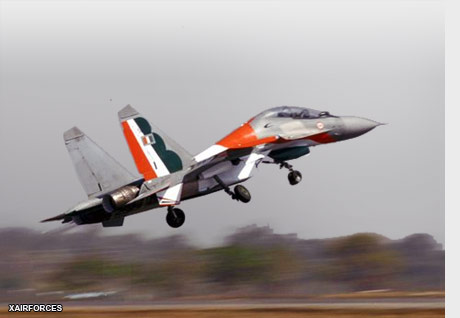 Chaired by Air Chief Marshal N A K Browne, the three day Commanders Conference of IAF began here today to discuss issues related to force modernization and capability enhancement to respond effectively during challenging times. Chaired by Air Chief Marshal N A K Browne, the three day Commanders Conference of IAF began here today to discuss issues related to force modernization and capability enhancement to respond effectively during challenging times.
"The IAF is witnessing unprecedented phase of modernization and capability enhancement and can effectively respond to any attempt at undermining India's national security," Browne said while addressing the Conference.
The conference is being attended by the Chiefs of IAFs seven commands and the Principal Staff Officers (PSOs).
"Emphasis would be on infrastructural development in North and North Eastern region to improve response time through forward basing of armed forces' assets and supporting the Indian Army in challenging conditions," IAF officials said.
Over the next three days, the commanders would discuss aspects related to infrastructure development and enhancing the capability of air warriors, the officials said.
Observing that transformation in IAF includes induction of force multipliers and air mobility platforms, IAF chief Browne said the process can be witnessed in all facets of capability building in the force.
"The transformational change can be witnessed in all facets of capability building that include not only combat platforms but also induction of force multipliers and air mobility platforms to provide strategic reach and operational flexibility," the IAF Chief said.
IAF's placement fair for air warriors on Saturday
(New Delhi, October 13, 2011, Agencies - www.expressindia.com):
The Indian Air Force will hold the sixth placement fair here on Saturday to provide resettlement opportunities to its air warriors in PSUs and corporate sector.
"More than 800 companies and 16,000 air warriors have registered with the IAF Placement Cell in last five years. The fair will be inaugurated by Defence Minister A K Antony who will release a pension handbook on the occasion," an IAF spokesperson said here today.
Since 2007, a total of 12,760 vacancies were received by the placement cell and 28,394 eligible air warriors were sponsored to various companies, the spokesperson said. Corporate groups and Public Sector Undertakings (PSUs) have been invited to participate in the fair.
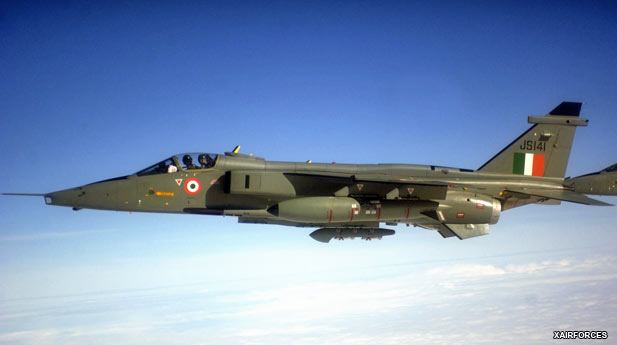
To achieve maximum number of confirmed appointments, the placement cell has initiated various measures such as on-site assistance for interested candidates, employee-employer interaction sessions and training cum induction programmes, the official said.
The cell is also promoting opportunities for self employment, entrepreneurship and franchise schemes for those interested in starting their own ventures, he added.
After declaring 2007 as the 'Year of Placement' for ex- servicemen, IAF has conducted special placement drives at frequent intervals to ensure smooth transition of air warriors into a second career.
The seven placement cells operating in various IAF Commands keep looking for possibilities for lateral absorption of air warriors into government organisation and PSUs on regular basis, the spokesperson said.
Go Bankrupt, Air Force Style
(New Delhi, October 12, 2011, By Madhav Nalapat - www.the-diplomat.com):
Just weeks from now, Indian Defence Minister A.K. Antony will announce whether the Eurofighter or Dassault will win the $12 billion contract for the supply of 126 front-line fighters for the Indian Air Force.
Consistent delays by Russia in procurement, slipshod service and repeated cost escalations elbowed out the MiG-35,while US reluctance to give India anything other than the 20th century F-16, as well as crippling conditions on local production sharing of the more futuristic F-18, put paid to the hopes of the Obama administration that the Indian taxpayer would bailout Lockheed or boost Boeing. That left the Saab Gripen, which was eliminated by the Defense Ministry from consideration, reportedly on the grounds that it had a less than optimal radar capability.
This columnist favoured the Gripen, not only because it’s much cheaper than the two other European Medium Multi-Role Combat Aircraft (MMRCA) under consideration, but because Saab would have been agreeable to the location within India of far more significant chunks of aircraft production than the Eurofighter consortium or Dassault, both of whom seem seek to confine production operations of higher technology items to Europe rather than partnering with India to lower overall costs. Unlike Germany and France, the Scandinavian countries are far more willing to enter into equal partnerships with Indian industry, and hence the acquisition of the Swedish aircraft would have boosted local capabilities far more than either of the two options now shortlisted.
Interestingly, while the choice of radar has been given as the reason why the lower cost Gripen was eliminated, the Eurofighter has the exact same radar system as the Swedish aircraft, made by the same manufacturer. Additionally, the lifecycle costs of the Eurofighter are believed to be nearly ten times that of the Saab option, while the costs of the Dassault option are reportedly eight times the cost of the Gripen, for every hour of flight. This will make operation of either of the two shortlisted variants prohibitively expensive for the Indian Air Force.
Purchasing white elephants has become the sport of choice for the Defense Ministry. The Indian Navy has bought the mothballed Admiral Gorshkov from Russia at a price that will cross the $3.2 billion mark, or three times the estimate given at the time the decision to purchase this aircraft carrier was made. Like the Eurofighter or the Dassault options, the Admiral Gorshkov (now re-christened Vikramaditya and awaiting induction sometime in 2012) will be hugely expensive to operate. Of course, as the just-concluded $2 billion deal for the ‘upgrade’ of the Mirage squadrons shows, the higher the cost, the more the hidden ‘sweeteners’ are likely to be.
While there have been news reports of the Italian relatives of a prominent political family in India showing an interest in the MMRCA acquisition, the Indian media has, as is its wont, not dared explore the possibility of any such connection. Instead, they have lapped up the Defense Ministry’s handouts, which tout the deal as giving ‘teeth’ to India’s air attack capability. That such teeth would be false teeth doesn’t seem to bother many. Thus far, the Defense Ministry has refused to budge from its policy of relying on foreign rather than Indian companies for big ticket items.
 Antony has presided over the biggest spending binge ever entered into by the Defense Ministry. This legacy is the polar opposite of that of previous Defense Minister V.K. Krishna Menon, who during his tenure sought to deepen ‘self-reliance’ for defence items and technology. Given the financial hole that Europe is in, the murderous expense involved in purchasing, maintaining and operating the Eurofighter or the Dassault Rafaele may be put down to charity. Antony has presided over the biggest spending binge ever entered into by the Defense Ministry. This legacy is the polar opposite of that of previous Defense Minister V.K. Krishna Menon, who during his tenure sought to deepen ‘self-reliance’ for defence items and technology. Given the financial hole that Europe is in, the murderous expense involved in purchasing, maintaining and operating the Eurofighter or the Dassault Rafaele may be put down to charity.
Photo: The Diplomat Blogs
IAF anniversary celebrations come to an end
(SHILLONG, October 12, 2011, THE TIMES OF INDIA - www.timesofindia.com):
The week-long celebrations of the 79th anniversary of the Indian Air Force, which commenced on October 2, culminated on Monday with Air Marshal S Varthaman, the Officer Commanding-in-Chief, Eastern Air Command (EAC), administering the pledge of allegiance to all personnel posted at the headquarter.
Various events, including Air Fest 2011, social evenings and traditional asnarakhanas, were organized during the celebrations. In his message, the AOC-in-C paid tribute to those who worked hard to make the IAF asone of the mightiest in the world. He highlighted the achievement of the Air Force and the contribution of the EAC during the preceding one year, including successful conduct and participation in various operational exercises.
IAF is witnessing an unprecedented phase of modernization, says Air Chief
(New Delhi, October 12, 2011, ANI - http://in.news.yahoo.com):
The Chief of the Air Staff, Air Chief Marshal NAK Browne, on Wednesday the Indian Air Force (IAF) is witnessing an unprecedented phase of modernization and capability enhancement and can effectively respond to any attempts at undermining India's National Security.
He exhorted all Commanders to uphold the 'People First Mission Always', vision of the Indian Air Force (IAF).
He also complimented them for their excellent professionalism and responsiveness during the recent Humanitarian and Disaster Relief Operations undertaken in Sikkim and Orissa
Addressing the Commanders at the three-day Air Force Commanders' Conference, which commenced at Air Headquarters, Vayu Bhawan, here, Air Chief Marshal Browne said: "The IAF is witnessing an unprecedented phase of modernization and capability enhancement and can effectively respond to any attempts at undermining India's Nationalecurity."
"The transformational change can be witnessed in all facets of capability building that include not only combat platforms, but also induction of force multipliers and air mobility platforms to provide strategic reach and operational flexibility," he added.
The conference is being attended by the Air Force Commanders of all the Operational Commands as well as the Training and Maintenance Commands, besides the Principal Staff Officers at the Air Head Quarters.
Over these three days, the Commanders would discuss key issues relating to Operations, Maintenance and Infrastructure development and most importantly, the HR issues relating to the training of the air warriors.
The key focus is likely to be on strategizing various aspects related to training and development of air warriors with special emphasis on consolidating flying training and development of air warriors to cope with the depletion in trainer aircraft resources.
An emphasis would be seen to be laid on the infrastructural development in the North and North Eastern areas to improve response time through forward basing of armed forces' assets and supporting the Indian Army in challenging conditions.
Amongst other issues, the discussions would also range from pace of progress in platform and weapon inductions and various processes to the effective integration of modern air defence radars and weapon systems to maintain requisite combat potential.
Various maintenance issues like the life cycle philosophies and modernization of maintenance practices to enable a more inclusive role for the Base Repair Depots in maintaining legacy systems would also be deliberated upon.
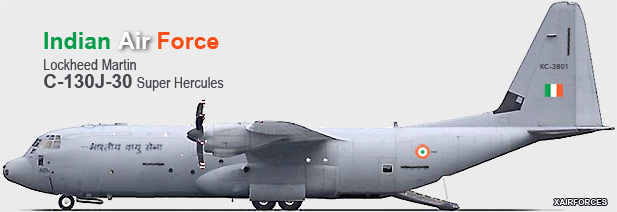
Based on the valuable insight gained during the successful induction of C-130 J aircraft, Commanders would also review the processes of the Foreign Military Sales (FMS) to ensure smooth induction of the C-17 aircraft. (ANI)
IAF commanders to review security situation
(New Delhi, October 11, 2011, PTI, IAF chief ACM N A K Browne - www.timesofindia.com):
Top commanders of the IAF will review the security situation and take stock of the operational preparedness of the Force at a conference beginning here tomorrow.
The three-day conference will be chaired by IAF chief ACM N A K Browne and will be attended by the vice-chief, commander-in-chiefs of IAF's seven commands and the Principal Staff Officer (PSOs).
IAF to have radar system in mountains for better security
(New Delhi, October 11, 2011, by K Daniel - www.indiandefence.com):
As a routine of the major security enhancement, the Indian Air Force (IAF) must demonstrate a formiable radar system in mountains and other places to make ways and establish fighter aircraft in Delhi and other urban areas for instant action to any visible attacks.
“I think by 2014, we must have an impressive radar network in the country. The most perilous part are the mountain places and that may involve a year more,” Airforce Chief Marshal NAK Browne announced here.
He informerd reporters on sidelines of Air Force Day parade here, “We have outlined plans which take care of the air defense of important metres, beginning from Delhi. This network is made up of radars early warning systems, missles with air bourne fighters inclusive.”
On acquiring the air space of Natural Capital Region (NCR) he emphasised, “Since Hindon is the nearest base, it is certainly going to be the correct area to establish the air defense figher”.
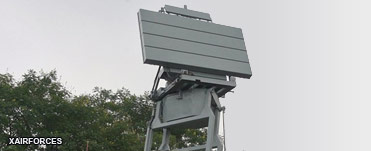 Further, he went on to say that the type of the aircraft expected here has not been discussed. “Whether it must be Sukhois or M-MRCA class of aircraft, the agrrement is not yet made but surely there would undoubtedly enchance air-defense fighter. On the incoming army exercise coded OP Sudarshan Shakti, he reiterated , “Members of the squad must be the strike cops i.e 21 corps from the Indian Army and the South Western Air Command (SWAC) from the IAF. Photo: IAF to have radar system in mountains for better security Further, he went on to say that the type of the aircraft expected here has not been discussed. “Whether it must be Sukhois or M-MRCA class of aircraft, the agrrement is not yet made but surely there would undoubtedly enchance air-defense fighter. On the incoming army exercise coded OP Sudarshan Shakti, he reiterated , “Members of the squad must be the strike cops i.e 21 corps from the Indian Army and the South Western Air Command (SWAC) from the IAF. Photo: IAF to have radar system in mountains for better security
IAF will induct its C-17 airlifters from 2013
(New Delhi, October 10, 2011, IANS - www.zeenews.india.com):
The Indian Air Force (IAF) will induct in June 2013 the first of the 10 C-17 Globemaster-III heavy airlifters it has purchased from the US, and then order six more.
AF chief, Air Chief Marshal Norman Anil Kumar Browne, told India Strategic defence magazine (www.indiastrategic.in) in an interview that Boeing would deliver all the already ordered 10 aircraft between 2013 and 2014, and that once the IAF was satisfied with their performance, six more would be ordered. By 2015, the induction of all the 16 aircraft should be complete.
"C-17 Globemaster III aircraft are expected to be inducted between 2013 and 2015," he said.
The Air Chief said that the IAF had actually planned to acquire 20 aircraft but right now, it had the Defence Ministry's approval for just 16.
The aircraft had done well during the rigorous tests for short takeoffs and night operations and the IAF is preparing a number of its airbases, including in the mountainous northern and northeastern region, for the C-17 and Lockheed Martin C-130J Super Hercules aircraft. The latter have, in fact, begun relief operations in the northeastern region following the recent earthquake.
Both the aircraft can be refuelled midair and would be networked with the IAF's air and ground assets.
The IAF hopes to sign the contract for the additional six C-17s within 2013. The contract for the first lot of 10 aircraft was signed in June this year in accordance with the US government's Foreign Military Sales (FMS) programme under a government-to-government deal for USD 4.1 billion, which included a training and support package as well as 30 percent offset investment into India's defence programmes.
Notably, Boeing officials had told a group of Indian journalists visiting the C-17 manufacturing facility at Long Beach in California last year that the company could accelerate production and deliver the required number before schedule.
Boeing has nearly completed the US Air Force (USAF) requirement, and its C-17 production line is due to close after the last few orders are delivered over the next three or four years. The production capacity has already been halved to 10 aircraft a year so that the factory can continue a little longer for a few more possible international orders.
Nearly 235 of these long-range heavy-lift aircraft have been delivered so far, and even with a small number of 10 or 16 airlifters, India will be its second biggest customer. The United Arab Emirates (UAE), with six aircraft, is the third largest.
USAF has a total order for 223 aircraft, and the C-17 has been extensively used to support combat operations in Afghanistan and Iraq as well as humanitarian missions across the world, including in Pakistan.
It may be noted that even Lockheed Martin is delivering all the six C-130J aircraft before their scheduled delivery time, and this is the first time that the IAF has received its aircraft from a foreign supplier without delay, on or before time, and without any additional demands on cost.
The IAF received its first C-130J in February 2011 and the last and sixth is due here November 11.
MoD approves offset proposals for India's 126 MMRCA deal
(New Delhi, October 10, 2011, Written by Anand, Arjun - www.machinist.in):
Indian Air Force (IAF) chief Air Chief Marshal Norman Anil Kumar Browne said that the winner of India's $10.4-billion tender for 126 combat aircraft is expected to be announced in November. India wants to close the deal before March 31, 2012.
The defence ministry on Friday approved the offset proposals for India’s biggest defence deal to buy 126 fighter planes at an estimate price of Rs 42,000 crore ($ 10.4 billion) paving the way for opening the commercial bids in ten days time.
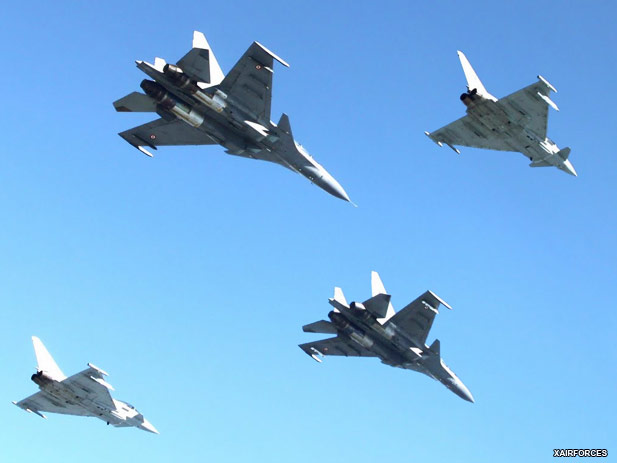
The offset proposals from Dassault Aviation (Rafale) and the Eurofighter consortium (Typhoon) were presented before the DAC by director general acquisition Vivek Rae. Besides the Defence Minister, the two-hour meeting was attended by the three Service chiefs, the Defence Secretary, the Secretary, Defence Production, the DG (Acquisition) and concerned joint secretaries in the Ministry.
After the bids are opened, the Defence Ministry will be able to determine the lowest bidder in the deal. In the MMRCA deal, foreign vendors bagging deals will have to invest back 50 per cent of the worth of the deal in Indian defence industry. This means the winning firm has to reinvest more than Rs 21000 crore in India, either alone or in partnership with an Indian company, in military, homeland security and civil aviation.
However it is understood that the procurement policy has a provision that allows MoD to discard L1 lowest cost bidder for 'strategic benefit' that the next highest bidder offers . The policy document is deliberately vague on what qualifies as strategic benefit, an exceptional ToT offer or partnership may be considered strategically beneficial.
After the bids are opened to evaluate the lowest bidder, the proposal will move to the Finance Ministry for its approval and it will then go to the Cabinet Committee on Security (CCS) for final nod by the government.
"In the middle of November, we shall be able to announce to the whole world which plane we have selected, the L1 vendor (lowest bidder)," Browne said in his interaction with reporters after he inspected the 79th Air Force Day parade here. "The process for acquisition of the MMRCA (Medium Multi-Role Combat Aircraft) is in its last lap and we should be able to open the bids in 10 days' time from now," he said. He added that after opening of the commercial bids, "complex calculations" would be done in a tabular format of the entire life-cycle cost, the acquisition cost and the technology transfer. It is expected to take two or three weeks to calculate these.
The two planes had been shortlisted in April this year after eliminating other competitors -- American Boeing's F/A-18, Lockheed Martin's F-16, Russian UAC's MiG-35 and Swedish Saab's Gripen -- through a rigorous technical and weapons evaluation process that lasted for over a year.
Together with Su-30 MKI, indigenous Light Combat Aircraft Tejas, Indo-Russian fifth generation fighter, the 126 MMRCA will be the mainstay of Indian Air Force in the coming decades. The winning company is also likely to receive a follow-on order of 80 odd MMRCA.
Speaking on other important IAF modernisation programmes, Air Chief Marshal NAK Browne said said that the C-130J Hercules and the Airborne Early Warning and Control System (AWACS) have been inducted and operationalised in good time. The IAF has inducted five of the six C-130J ordered from the US under a $1 billion deal in 2007 and is looking to place orders for six more in the near future. It is also planning to deploy the additional six aircraft at the Charbatia air base in Orissa. The IAF has also inducted all three AWACs aircraft procured from Israel and has started using them in exercises.
He said that the planned induction of the C-17 Heavylift aircraft along with medium and heavylift choppers will increase IAF's operational flexibility. India recently signed a $4.1 billion deal with the US for procuring 10 C-17 aircraft, which will be alongside the C-130Js at the IAF base here.
On the upgrade programmes involving the fighter and transport aircraft, he said, "Upgrades of Jaguar, Mirage 2000 and MiG 29 fighter aircraft along with An-32 transport aircraft are under way and will help in enhancing their operational relevance."
Inexperienced young pilots are crashing MiGs: IAF chief N.A.K. Browne
(New Delhi / Ghaziabad, October 9, 2011, Written by Anand, Arjun - www.indiatoday.intoday.in):
As the MiG-21s enter the sunset years in the Indian Air Force (IAF), the Chief of Air Staff, Air Chief Marshal NAK Browne, said on Sunday that most of the recent crashes involving the ageing aircraft were caused by the inability of inexperienced pilots to handle its fast landing speed.
Five aircraft have crashed since Browne took over in July this year, three of which were MiG-21s- once dubbed "flying coffins" for their high crash rate. At least half of almost 1,000 of these aircraft were lost in accidents since they were first inducted in the late 1960s.
"Unfortunately, except for one case, the other cases point towards the inexperience of young pilots who were not able to handle the landing and approach," said Browne, after the 79th Air Force Day parade at Hindon airbase near Delhi.
He was talking about four MiG-21s that crashed this year. The crash that took place on Friday in Rajasthan has also been attributed to human error. Another aircraft had crashed near Patiala in Punjab on September 6. In August, a MiG-21 crashed near Bikaner. The first accident involving the aircraft this year was in Madhya Pradesh in February.
Even before Browne talked about the safety of the aircraft, the IAF had decided it would no longer train inexperienced pilots on the MiG-21s, which are being phased out gradually.
The current batch of pilots undergoing training would be the last course on the aircraft. Even the upgraded version "Bison" has a handling problem as its landing speed is above 300kmph, which is much faster than other fighter jets.
But the question being raised is whether the move comes too late in the day after the loss of many precious lives and valuable air assets. Generations of IAF pilots have trained on the MiG-21s and its high approach speed for landing was always known to be a challenge for rookie pilots. It requires great flying skills to handle the Soviet-era aircraft.
The IAF has for long faced a problem with the training of pilots. They are trained in stages, with the cadets beginning on a basic trainer aircraft before moving on to the complex jets and supersonic fighters.
But the IAF has now trained around 200 pilots in the last two years straight on the jets after it grounded its basic trainer, the HPT-32, after a series of crashes killed several young trainees. It has gone shopping for a basic trainer and selected the Swiss Pilatus P-7, but the contract has not been finalised yet.
The air chief accepted that training of pilots was one of the major areas of concern. "We are not very happy about their (pilots) going directly for stage- III training on the MiGs. But we actually have no alternative," he said.
The IAF has only 52 Hawks, which are not sufficient to meet the training requirement.
"The basic trainer aircraft is in the final stage of procurement and the case is with the finance ministry. I am extremely confident that by the end of this month ... we should be able to sign the contract with Pilatus," he said.
The IAF plans to phase out the MiG-21s, which have been the mainstay of its fleet for the last many decades, by 2017. But the problem is finding a replacement. The Light Combat Aircraft (LCA) being built at home is still far from being delivered. It was meant to be a replacement for the MiG-21s but the final operational clearance for the aircraft has been delayed by a year. It was expected to be given final clearance by the end of this year.
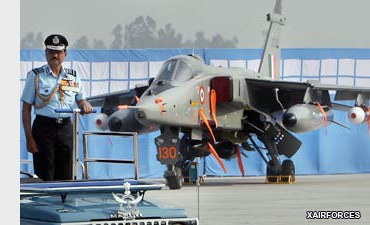
Photo: Air Chief Marshal NAK Browne inspects a Parade during the 79th Air Force Day in Hindon, Ghaziabad.
IAF on the path of modernisation: Air Marshal D Kukreja
(Banglore, October 8, 2011, DNA - www.dnaindia.com):
Indian Air Force enters the 79th year of its history today. During this period, the Air Force has been the lynchpin of India’s defence. At the time of its inception in 1932, the role of the Air Force was restricted to providing tactical support to the Army, while the strategic role of bombing and providing was retained with the Royal Air Force Squadrons in India.
The past 79 years have witnessed the Indian Air Force transformfroma fledgling companion to the Royal Air Force to a modern, first rate, professional force, with rich tradition and legacy.
I, as an Indian and an Air warrior, am proud to be part of this elite force. The IAF today is poised on the path of modernisation and is transforming itself into a potent strategic force, with full spectrum capability. With the induction of state-of-the art platforms, equipment and weapons, we are witnessing a paradigm shift in our operational philosophy. While change is the hallmark of growth and progress, the biggest challenge facing us in the coming years is to manage this fast-paced change effectively, without compromising on our high operational standards. The new state-of-art systems would lead to a major upgradation of our combat potential.
The future is certainly challenging, yet it would provide enormous potential for growth. In times ahead, the IAF would be simultaneously operating old as well as new-inducted air craft and equipment.
Operations across such a broad spectrum inventory would constantly test our skills, our ingenuity and our ability to innovate.
The nation has reposed a high degree of trust and confidence in our capabilities. The vision statement of IAF ‘People first, Mission always’, guides all our actions. As a combat force, IAF focus is on ‘Operations’. Everything we do revolves around maintainingthe highest operational standards, at all times. In all our endeavours and tasks, our core values of ‘Mission, Integrity, Excellence’, get etched indelibly.
We, in Training command, are committed to ensure high standards of training, notwithstanding the challenges of modernisation and utilisation of ageing military hardware and weapon systems.
It is the endeavour of every Air Warrior of the Training command to continue with the traditions of the IAF and stride purposefully towards becoming an enviable and a proud professional fighting force.
As the Indian Air Force celebrates its 79th year of glorious service to the Nation, I take this opportunity to convey my warm greetings to all citizens of the country, to all Air Warriors, NCs (E), DSC personnel, civilians and their families. — The writer is air officer commanding-in-chief, training command.
Combat aircraft for IAF:Stage set for bids
(New Delhi, October 8, 2011, By K.V. Prasad - www.thehindu.com):
Defence Ministry approves offsets evaluation reports of two competitors
The acquisition process for Indian Air Force Medium Multi-Role Combat Aircraft (MMRCA) reached the final stage on Friday after the Ministry of Defence approved the offsets evaluation reports of the two competitors – French Dasault's Rafale and European consortium Eurofighter.
With the Defence Acquisition Council chaired by Defence Minister A.K. Antony clearing the offsets proposals worth over Rs. 20,000 crore, the stage is set for the opening of the commercial bids submitted by the two manufacturers.
Ministry officials said the sealed bids for the aircraft submitted would be opened in a few days — likely toward the end of the month — in the presence of representatives of the two manufacturers.
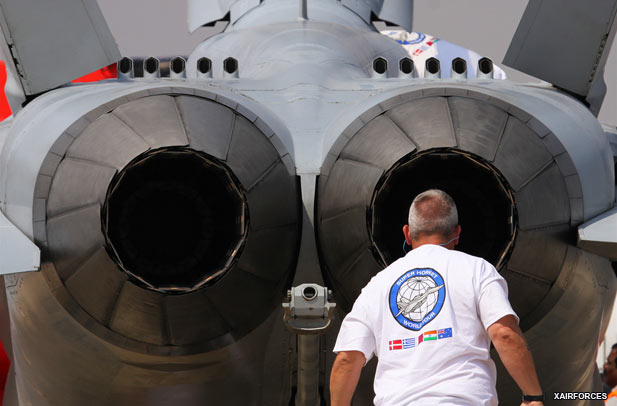
Clearance
Once the lowest bidder is identified, the process to negotiate the cost would set in leading to eventual clearance by the Cabinet Committee on Security.
Earlier this year, Mr. Antony had said the contract should be signed before the end of the current financial year.
While the Defence Procurement Policy makes it mandatory for all purchases of Rs. 300 crore to have at least 30 per cent offset, in the case of the MMRCA it is 50 per cent.
Offset clause
As per the offset clause, the eventual winner of the contract would have to source 50 per cent of the value of the contract from domestic industry. The offset evaluation report shows the tie-up the French company or the European consortium could have with Indian partners could be in the form of joint ventures. For instance, the offsets agreements in the case of MMRCA could well run into over 100 companies each by the competitors.
The IAF plans to acquire 126 aircraft, 18 of them in ready-to-fly condition, while the rest would be under licence production in India. The delivery schedule envisages the arrival of the first aircraft 36 months after the signing of the contract. Overall the entire contract could take up to 12 years for delivery of all the aircraft. The possibility of the numbers going up was not be ruled out by the IAF.
In April this year, the Ministry shortlisted Rafale and Eurofighter from a field of six eliminating American Boeing (F/A-18), Lockheed Martin (F16 Super Viper), Russian MiG35 and Sweden's SAAB (Gripen).
Surya Kiran aerobatics team to take to skies again
(Hindon (Ghaziabad), October 8, 2011, IANS - www.zeenews.india.com):
India's nine-aircraft Surya Kiran aerobatics team was badly missed during the Air Force Day parade here on Saturday, but its disbanding this February is not the end of the road for it yet.
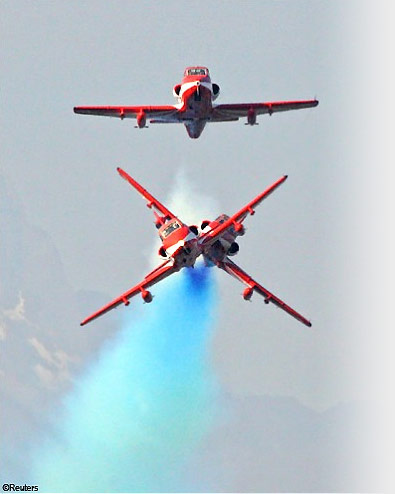 The Surya Kiran will once again soar into the skies, with the Indian Air Force deciding to revive it three years from now with the British Hawk Advanced Jet Trainers (AJTs) that India will specially procure for the aerobatics team by 2014. The Surya Kiran will once again soar into the skies, with the Indian Air Force deciding to revive it three years from now with the British Hawk Advanced Jet Trainers (AJTs) that India will specially procure for the aerobatics team by 2014.
This announcement was made by IAF Chief Air Chief Marshal Norman Anil Kumar Browne while addressing the air warriors after reviewing the 79th Air Force Day parade - that included the aerial display - at the air base here on the edge of the national capital.
Browne also said it was "painful" to let go of the team, though it was only for a few years. He also promised that the Surya Kiran will enthrall the entire nation, as well as aviation enthusiasts abroad once again.
"This year, we had to take the painful decision of temporarily disbanding the nine-aircraft Surya Kiran aerobatics team. But we owe it to the nation to revive the team again and I assure you that in three years from now, the Surya Kiran will once again rise over the skies in Hindon and perform across the length and breadth of India, and indeed around the globe, this time newly painted in the national colours on the Hawk aircraft," Browne said in his address at the parade.
In the nearly one-and-half decades of its existence, this was probably the first time the Surya Kiran team did not perform at the Air Force Day parade, and they will now be missed for two more years.
The Surya Kiran flew in the Indian-made HJT-16 Kiran MkII trainer aircraft all along, but they had to give up their aircraft to meet the training requirements of rookie Indian Air Force (IAF) pilots after the HPT-32 Deepak trainer fleet was grounded last year following frequent crashes, claiming 23 pilot fatalities and 108 engine-cuts.
Apart from the Kirans, the IAF is now using the Hawks AJTs, bought in 2004 from British firm BAE Systems and delivered in 2008, for training newly recruited pilots.
The IAF has shortlisted the Swiss Pilatus PC-7 basic trainer, for which the contract is expected to be signed later this month. It is buying 75 of the PC-7s for training purposes and is also remodelling its syllabus for the young pilots.
India is expected to place an order for over a dozen Hawk AJTs for the Surya Kiran team, apart from the 66 it has already bought for training purposes in 2004 and the additional 57 for air force and navy pilot training.
Photo: Surya Kiran aerobatics team (Reuters)
IAF chief blames rookie pilots for MiG crashes
(New Delhi, October 8, 2011, HT Correspondent, Hindustan Times - www.hindustantimes.com):
Inexperienced pilots may have been responsible for some recent MiG-21 accidents, Indian Air Force chief Air Chief Marshal NAK Browne said on Saturday. Of the six IAF aircraft that crashed this year, four were MiG-21 variants, including the fighter that crashed in Rajasthan on Friday. "As far as the last two to three accidents involving the MiG-21 (are concerned), unfortunately except for one case the other cases are pointing towards inexperience of young pilots," Browne told media on the IAF's 79th anniversary.
He said pilots would not be training on the unforgiving MiG-21 after December 2012.
Hawk advanced jet trainers would simplify the conversion of fledging fighter pilots from subsonic Kiran trainers to supersonic fighters such as Sukhoi-30, Jaguars and Mirage 2000.
"After December 2012 all pilots will be trained on Hawks. So this is a very crucial period. We have to be very careful. This is also linked to the basic trainer aircraft, which is a starting point. If the base is good, then you will not have this problem," the air chief said.
The defence ministry is on the verge of signing a contract for acquiring Pilatus PC 7 basic trainers.
The sudden leap from Kiran trainers to MiG-21s is quite daunting as rookie pilots face huge variation in speed, performance and technology.
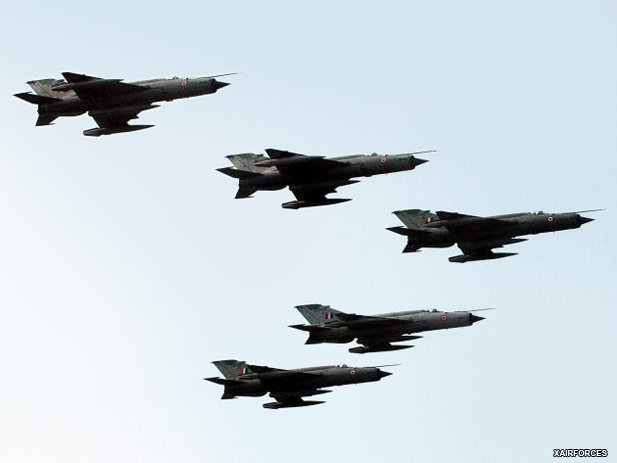
Of the 793 MiG-21s inducted into IAF since 1963, more than 340 have been lost in crashes.
Photo: In this file photo MiG-21 aircrafts are seen during the Air Force Day Parade Rehearsal at Palam Aiir Base in New Delhi. Photo: Sandeep Saxena (above)
Bikaner, Aug 2 : A MiG-21 fighter aircraft crashed after taking off from Naal airfield in Rajasthan’s Bikaner district killing the pilot. Defence spokesperson S D Goswami, “The pilot ejected but died due to injuries sustained by him”. He added, The MiG-21 ‘Type-96′ aircraft was on a routine sortie and crashed near the airfield, which is about 15 kms from Bikaner city. (below)
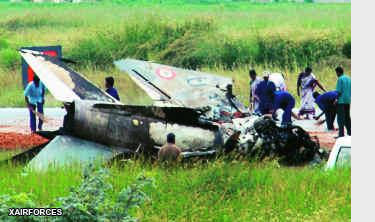 This is the second crash of a MiG series fighter aircraft this year. On February 4, an IAF MiG-21 ‘Bison’ fighter plane had crashed apparently due to an engine problem while on a routine sortie in Madhya Pradesh’s Sheopur district but the pilot had ejected safely. In 2010, a total of 10 IAF aircraft crashes took place including four MiG-27 and two MiG-21 planes This is the second crash of a MiG series fighter aircraft this year. On February 4, an IAF MiG-21 ‘Bison’ fighter plane had crashed apparently due to an engine problem while on a routine sortie in Madhya Pradesh’s Sheopur district but the pilot had ejected safely. In 2010, a total of 10 IAF aircraft crashes took place including four MiG-27 and two MiG-21 planes
Biggest defence deal proposal okayed
(New Delhi, October 7, 2011, DHNS - www.deccanherald.com):
The defence ministry on Friday approved the offset proposals for India’s biggest defence deal to buy 126 fighter planes at an estimate price of Rs 42,000 crore ($ 10.4 billion) paving the way for opening the commercial bids around Diwali.
Two European fighters – French Rafale and Eurofighter Typhoon – are in the fray after the first round of selection overtaking four other competitors including two US fighters. India wants to close the deal before March 31, 2012.
Indian Air Force chief N A K Browne, who attended Friday’s Defence Acquisition Council meeting, stated on Monday that the DAC meet is the last internal defence ministry meeting before the bids are opened by the third or fourth week of October.
Even though defence ministry officials are tight-lipped about the details of the DAC decisions, the panel headed by Defence Minister A K Antony is understood to have taken the final decision on the controversial offset issues associated with the medium multi-role combat aircraft deal.
Procurement norms
According to Indian defence procurement norms, 30 per cent of all foreign military purchases worth more than Rs 300 crore are reinvested in Indian defence industry to spur growth in domestic military industry. For the MMRCA deal, the offset was fixed at 50 per cent, which sparked resentment among the competitors.
This means the winning firm has to reinvest more than Rs 21000 crore in India, either alone or in partnership with an Indian company, in military, homeland security and civil aviation.
The offset proposals from Dassault Aviation (Rafale) and the Eurofighter consortium (Typhoon) were presented before the DAC by director general acquisition Vivek Rae.
Asked about the falling values of rupees on the MMRCA deal, Brown stated that availability of funds would not be a problem in realising the contract. Once a contract is signed, it will come under the category of “committed liability” of the government, for which provisions are made in the budget.
Subsequent to the DAC approval, the deal has to be cleared by the Finance Ministry and the Cabinet Committee on Security.
Together with Su-30 MKI, indigenous Light Combat Aircraft Tejas, Indo-Russian fifth generation fighter, the 126 MMRCA will be the mainstay of Indian Air Force in the coming decades.
The winning company is also likely to receive a follow-on order of 80 odd MMRCA.
Indian MiG pilots poorly trained – AF Commander
(Moscow, October 7, 2011, TASS - www.english.ruvr.ru):
The Indian Air Force says it has already lost about one half of a thousand or so MiG-21 fighter planes that it procured from the Soviet Union. The main factor in this loss is accidents, mostly due to human error linked to inadequate pilot training.
There has been a pronouncement about this from Air Force Commander Norman Anil Kumar Brown.
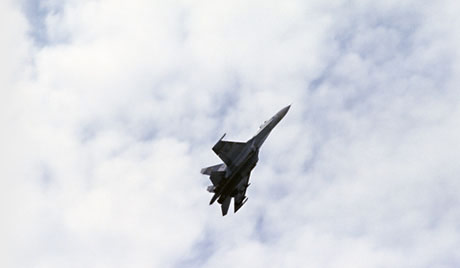 India’s MiG fighters upgraded India’s MiG fighters upgraded
(Moscow, October 7, 2011, IF - www.english.ruvr.ru):
Russia’s MiG plane-makers are successfully upgrading the fleet of MiG-29 jet fighters once sold by them to India.
On Friday, an Indian pilot successfully carried out a 90-minute test flight on an upgraded MiG near an airfield southeast of Moscow.
Photo: RIA Novosti
IAF likely to induct 5th-gen fighters by 2017
(New Delhi, October 4, 2011, PTI - Aman Malik - www.sofindia.indiatimes.com):
The IAF will procure 214 FGFAs, of which 166 aircraft will be single seaters, while the remaining will be twin seaters
The Indian Air Force (IAF) is likely to begin inducting so-called fifth-generation fighter aircraft (FGFA), to be jointly developed by India and Russia, into its fleet from 2017, air chief marshal N.A.K. Browne said on Monday.
The IAF will procure 214 FGFAs, of which 166 aircraft will be single seaters, while the remaining will be twin seaters. “The twin-seater variety would be assembled at Hindustan Aeronautics Ltd (HAL),” Browne said.
In December, the two countries had announced a preliminary draft agreement for the FGFAs at an estimated project cost of $25-30 billion (Rs1.24-1.48 trillion today). Browne, however, said the design agreement needs to be finalized and so the final deal was “a long way off”.
FGFAs are technologically more advanced than fourth-generation jet fighters in most aspects, including stealth, internally carried air-to-air and air-to-ground weapons, advanced avionics and integrated computer systems.
Most of the IAF’s inventory is of Russian origin. But in recent years, India has been sourcing military hardware from other countries, including Israel, Britain and France.
Meanwhile, the ministry of defence (MoD) could open the financial bids for acquiring 126 medium multi-role combat aircraft for the IAF in the next couple of weeks. There are two contenders left in the race for the deal. “The envelopes will be opened by the third or fourth week of October,” Browne said.
Six global defence companies—Lockheed Martin Corp., Boeing Co., European Aeronautic Defence and Space Co. NV (EADS), Dassault Aviation SA, Saab AB and RSK MiG—were initially in the fray. MoD shortlisted Dassault and EADS in April, following technical field trials.
Browne said a meeting of the defence acquisition council is likely to be held on Friday, which will consider various aspects related to the deal.
According to defence procurement procedure (DPP), under which India makes acquisitions from foreign vendors, the shortlist is followed by the opening of commercial bids. On the basis of the bids, MoD will determine the lowest bidder, after which cost negotiations will begin.
“We want to maintain a constant force level of 34 squadrons till 2022, by when we could have 42 squadrons,” Browne said.
“The IAF is facing a serious problem of obsolescence. Barring the Sukhois, most other aircraft are in the process of being refurbished or being phased out,” said Deba Ranjan Mohanty, senior fellow at New Delhi-based Observer Research Foundation.
The IAF is also set to acquire six more C-130J Super Hercules transport aircraft manufactured by Lockheed Martin in addition to the six that had been ordered in 2008 at a cost of $1.05 billion.
The IAF will also acquire an additional 59 Russian-origin Mi-17 V5 helicopters, the IAF chief said. It had ordered 80 such helicopters in 2008. Browne also said that in addition to the IAF, the home ministry was also looking at acquiring an unspecified number of the same helicopters.
Photo: Buying plans: Air chief marshal N.A.K. Browne. (www.livemint.com)
IAF to get first lot of Mi-17 copters by October
(New Delhi, October 3, 2011, PTI - www.exclusiveaircraft.co.uk - www.sofindia.indiatimes.com - www.truthdive.com By Ayyappa Prasad):
Augmenting its chopper fleet, the Indian Air Force (IAF) will induct the first batch of Russian-origin Mi-17 V5 helicopters by mid-October.
India had in 2008 signed a deal with Russia to induct 80 Mi-17 V5 helicopters for strengthening its chopper fleet for humanitarian and disaster relief missions and transport operations. "We are going to induct the first batch of Mi-17 V5s from Russia by the second week of the month, and by March next year we will have 26 of them," an IAF official said.
They said one of the first few helicopters would be sent to the northeast sector and will be deployed at the Bagdogra air base under the 156 helicopter unit.
The compliment of all 80 helicopters is likely to be inducted by late 2013 or early 2014, IAF sources said. The IAF is also looking to induct another 59 such choppers to replace the older Mi-17 variants and the Mi-8 choppers.
The IAF has plans of procuring over 230 helicopters.
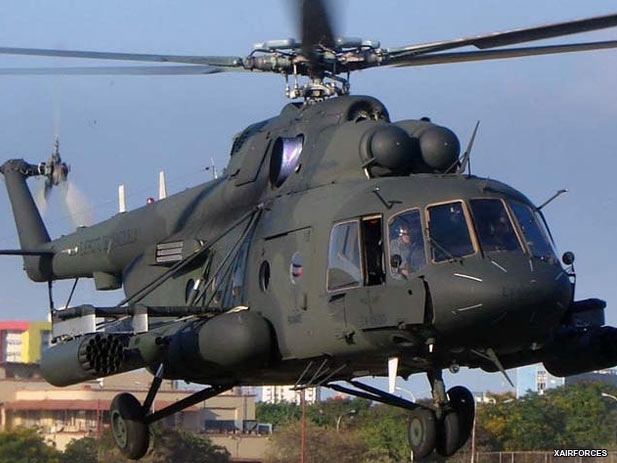
Photo: Chandigarh Airforce base to assemble Venezuelan MI-17 V5 helicopters.
(TruthDive) After a joint military exercise with Sri Lanka, India announced that a similar exercise with Singapore would take place at the air force base at Kalaikunda in West Bengal. The Air force of both the countries would engage in combined operations.
Republic of Singapore Air Force JMT activities for 30 days staring October 14 will sent 150 personnel, with eight F-16 D+ aircraft, one P STAR radar, and two units of RBS-70 surface-to-air missile firing units, the Indian Air Force will field Mig-27 and Mig-21 aircraft of the resident squadrons operational at the airbase.
The RSAF pilots will also carry out air-to-ground firing practice at the IAF’s Dudhkundi firing range, 40 km from the airbase, and will carry out night flying training at the airbase for the first time.
In the Midnapore District in the state of West Bengal, about 130 km from Calcutta is the Major Airbase of Kalaikunda. Established way back during the Second World War, this desolate village turned airstrip is now a major establishment on the IAF’s Orbat.
Ever since its reactivation in 1955, Kalaikunda had been home to Mystere Squadrons, Vampires, Hunters, Canberras, MiG-21s, Su-7s, and now MiG-27s. Kalaikunda has a large number of war birds on display, approximately seven preserved. A number of hunter airframes have been noticed lying derelict around the airbase.
It is suspected that at least one Sukhoi-7 airframe is lying around in the airbase. In the late 70s, one Spitfire airframe, which was lying as a decoy, was recovered and auctioned off to the UK Collectors.
Singapore declared independence from Britain unilaterally in August 1963, before joining the Federation of Malaysia in September. Singapore was expelled from the Federation two years later, after a heated conflict between the state’s PAP government and the federal government in Kuala Lumpur.
Three years after Singapore had formally declared independence on August 9, 1965, the RSAF took flight as the Singapore Air Defense Command (SADC) on September 1, 1968.
In January 1968, the British had announced the imminent withdrawal of all their troops east of Suez by September 1971. When Britain brought forward its plan to withdraw its forces, the SADC was suddenly entrusted with a huge responsibility and resources.
Britain’s former air bases – Tengah, Seletar, Sembawang and Changi – were handed over to the SADC, as well as its air defense radar station and Bloodhound II surface-to-air missiles. Prior to then, Singapore had depended completely on Britain’s Royal Air Force for its air defense, while the newly established Singapore Armed Forces (SAF) had concentrated its efforts mainly on building up the Singapore Army. On April 1, 1975, the SADC was renamed the Republic of Singapore Air Force (RSAF).
IAF to Deploy Sukhoi SU-30 MKIs at Jodhpur Airbase
(Jaipur, September 30, 2011, PTI | Sandeep Dahiya - www.truthdive.com):
Deploying its lethal combat arsenal near the Indo-Pak border, the Indian Air Force(IAF) is going to base a squadron of its Sukhoi SU-30 MKI fighter aircraft at the Jodhpur airbase in the Rajasthan desert.
The squadron of air superiority Sukhois will be operational at the strategically vital Jodhpur air base by the first week of November, sources in the IAF said today. The border will be just a two minute flight away from Jodhpur.
It is the first Sukhoi-30 squadron to be deployed anywhere in the Western sector, the sources said, adding that the second squadron along the Western sector will be raised in Halwara in Punjab.
Till now, the Sukhois have been deployed in six squadrons. They are stationed in the Eastern sector in Tejpur and Chabua, Bareilly in Uttar Pradesh and at its home base at Lohegaon in Pune.
The IAF is planning to induct a total of 272 Sukhois from Russia by 2017.
The twin-engined Russian-origin Sukhois are now produced under licence at Hindustan Aeronautics Limited (HAL) in Bangalore in India. India is also planning to equip the aircraft with Brahmos super-sonic cruise missile.
Sukhoi 30s can fly for more than 10 hours without refuelling, the sources added.
The first Sukhoi 30 was inducted in the late 90s. The IAF started inducting the MKI version in early part of this decade. First batches of the MKI version aircraft are going to be upgraded under an over Rs 11,000 crore plan jointly by Russia and HAL.
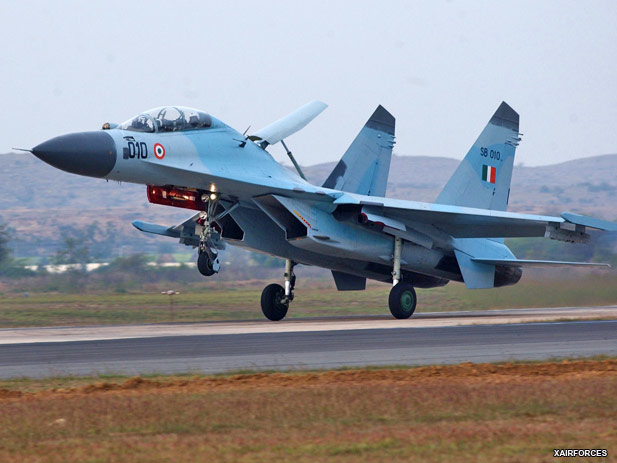
Photo: Strengthening its presence along Pakistan border, the Indian Air Force will deploy two squadrons of its frontline air superiority Su-30MKI fighter here. "We have decided to deploy two squadrons of Su-30MKI fighter squadrons in Jodhpur in next two years," South Western Air Command chief Air Marshal A K Gogoi told reporters here. Gogoi is on a three-day visit to the air force bases in and around Jodhpur. Jodhpur will be the first Su-30MKI base along the Pakistan border. Till now, the IAF has deployed its main strike fighter in Lohegaon near Pune, Bareilly, and Tezpur and Chabua in Assam. IAF also plans to deploy the aircraft at its Halwara air base in Punjab. IAF has started operating Su-30s in high-altitude areas too and its squadrons on a regular basis practice flights from the Leh air base in Jammu and Kashmir. Talking about strengthening air surveillance capabilities, Gogoi said medium power radars have been deployed under the command, which will be the first one to use them. (JODHPUR: Apr 20, 2011 THE TIMES OF INDIA)
Russian helicopters arrive in India
(Moscow, September 30, 2011, Interfax - www.english.ruvr.ru):
The first batch of the Russian Mil Mi-17B5 helicopters has arrived at an air base in the Indian northwestern state of Punjab.
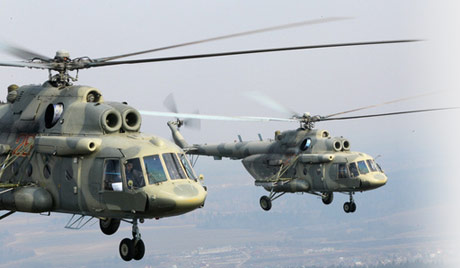 For years, India’s air forces have been using Russian Mil Mi-17 helicopters in the conditions of rough mountain terrain in the states of Ladakh, Arunachal Pradesh and Himachal Pradesh. For years, India’s air forces have been using Russian Mil Mi-17 helicopters in the conditions of rough mountain terrain in the states of Ladakh, Arunachal Pradesh and Himachal Pradesh.
The recent batch consists of upgraded versions of the helicopter to be used for the transportation of troops and military vehicles and for rescue and emergency operations.
The contract for the supply of 80 helicopters worth $1,354bln was clinched in 2008.
All assembly work and checks will be performed by Russian experts accompanying the cargo.
Photo: RIA Novosti
Russian MiGs in great demand
(Moscow, August 12, 2011, IF - www.english.ruvr.ru):
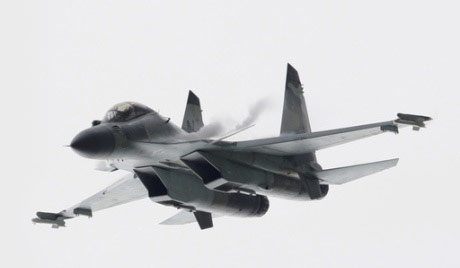 The backlog of orders of the Russian aircraft-building corporation MiG has exceeded $4bln, the director of the company Sergey Korotkov declared in his interview for the RIA Novosti news agency on Friday. The backlog of orders of the Russian aircraft-building corporation MiG has exceeded $4bln, the director of the company Sergey Korotkov declared in his interview for the RIA Novosti news agency on Friday.
He pointed out a steady demand for Russian jet fighters. In March last year the corporation signed a new contract with the Indian Defence Ministry for delivering 29 MiG-29 jets to India.
Earlier, in 2004, the parties signed an agreement to sell 16 such jet fighters for the Indian Air Force. 11 of them have already been delivered and the rest will be provided by the end of the year, Korotkov said.
Photo: RIA Novosti
Russia to supply new MiG aircraft to India
(Moscow, August 4, 2011, by Nehay Oleg - www.english.ruvr.ru):
Russian Aircraft Corporation MiG has started assembling carrier-based MiG-29K/KUB fighter jets to fulfill a contract concluded with India. It will supply a batch of 29 aircraft.
Corporation MiG is a leading fighter jet producer in the world. It produces multi-purpose ship-borne MiG-29 aircraft with one seat or two seats. India shows great interest in these aircraft says, the general-director of the corporation, Sergei Korotkov.
“Two years ago, India requested us to demonstrate the landing of MiG-29K/KUB fighter jets on a carrier cruiser and their attacking capability under a contract signed to purchase 16 aircraft. When we fulfilled it successfully, India gave the green light to deliver them. The corporation has supplied more than half of the consignment and the fighter jets are being used in India. They have over one thousand flight hours altogether. We will supply all aircraft under the contract by the end of the year. We signed another contract with India to supply 29 fighter jets. Today, we launched assembling these aircraft and started carrying out the second stage of the contract,” Sergei Korotkov said.
The MiG-29K/KUB was originally developed under a request submitted by the Indian Defence Ministry. This is a 4 plus-plus generation fighter jet that has an advanced air frame made out of composite materials.
Journalists got an opportunity to watch how the advanced jet is being produced at its presentation. Work is going on in a huge shop to carry out three export contracts. Besides ship-borne aircraft for India, fighter jets are being assembled in the shop for the Myanmar Air Force. The corporation will supply about 20 jets to Myanmar. At the same time, some of the aircraft previously supplied to India are being modernized, says the deputy general-director of the MiG Corporation, Vladimir Barkovsky.
“At present, we are modernizing Mig-29 fighter jets supplied earlier. We delivered more than 60 such aircraft. During the first stage four aircraft are being modernized in Moscow and another two in Nizhny Novgorod. At the same time, we will deliver modernization technology to India, and the corporation will supply complete sets for assembling,” Vladimir Barkovsky said.
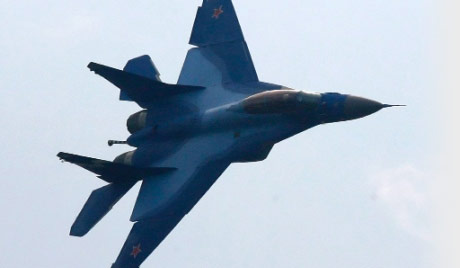 The MiG-29 fighter jets are also being modernized for Peru and another two countries. The corporation is examining several other contracts. The modernization of an aircraft will cost up to 30 percent of the price of a new one. During the modernization, avionics will be replaced, new radar and additional weapons will be installed and the fuel tank will be expanded. In short, this trend in cooperation is quite promising and economically expedient. The MiG-29 fighter jets are also being modernized for Peru and another two countries. The corporation is examining several other contracts. The modernization of an aircraft will cost up to 30 percent of the price of a new one. During the modernization, avionics will be replaced, new radar and additional weapons will be installed and the fuel tank will be expanded. In short, this trend in cooperation is quite promising and economically expedient.
Photo: RIA Novosti
---------------------------------------
Source: Thursday 14 October 2011 - www.xairforces.net
(13.10.2011)
|